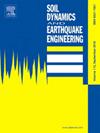Seismic stability of anchored slopes considering tension-shear coupling effect by modified pseudo-dynamic approach
IF 4.2
2区 工程技术
Q1 ENGINEERING, GEOLOGICAL
引用次数: 0
Abstract
Anchorage technology has been widely promoted and applied in many important slope engineering projects. However, the existing standard methods for seismic design of anchored slopes only consider the axial action of the anchor rod, ignoring its shear resistance, which greatly underestimates the reinforcement effect. Based on the limit equilibrium theory and the modified pseudo-dynamic method, this paper takes into account the “tension-shear” coupling effect of anchor rods and provides a closed-form solution for the safety factor of anchored slopes under seismic conditions. It analyzes the influence of different factors when considering the “tension-shear” coupling effect of anchor rods versus only considering the tension effect on the safety factor. This method is compared and validated. The results show that when the anchoring angle is large, the safety factor is greater when considering the tension-shear coupling effect of anchor rods compared to only considering the tension effect, indicating that traditional design methods seriously underestimate the shear resistance of anchor rods. There exists an optimal anchoring angle for anchor-reinforced slopes (approximately equal to the friction angle), at which the reinforcement effect is better. Additionally, the larger the anchor rod diameter, the greater the lateral shear resistance and the higher the safety factor. For the horizontal acceleration coefficient of 0.1, a 16 mm anchor rod offers 47.8 % more safety than a 10 mm one. The closer the input seismic wave frequency is to the natural frequency of the anchored slope, and the smaller the damping ratio, the lower the safety factor. The safety factor decreases by 2.64 % for vibration periods Ts of 0.10s and by 13.1 % and 37.2 % for vibration periods Ts of 0.15s and 0.20s. Compared with the pseudo-static method and the traditional pseudo-dynamic method, the method proposed in this paper can extensively quantify the stability of anchored slopes under different seismic wave frequencies and is more suitable for practical use. The results can provide valuable references for the current seismic design of anchored slopes and will help engineers better understand the working mechanism of anchor-reinforced slopes.
求助全文
约1分钟内获得全文
求助全文
来源期刊

Soil Dynamics and Earthquake Engineering
工程技术-地球科学综合
CiteScore
7.50
自引率
15.00%
发文量
446
审稿时长
8 months
期刊介绍:
The journal aims to encourage and enhance the role of mechanics and other disciplines as they relate to earthquake engineering by providing opportunities for the publication of the work of applied mathematicians, engineers and other applied scientists involved in solving problems closely related to the field of earthquake engineering and geotechnical earthquake engineering.
Emphasis is placed on new concepts and techniques, but case histories will also be published if they enhance the presentation and understanding of new technical concepts.
 求助内容:
求助内容: 应助结果提醒方式:
应助结果提醒方式:


